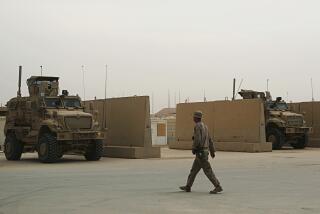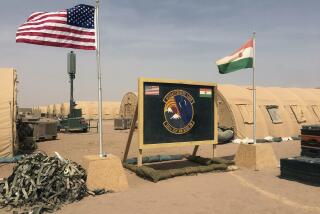Obama expected to announce major Afghan drawdown
Reporting from Washington — President Obama plans to announce a troop reduction in Afghanistan that Pentagon and other administration officials say is expected to bring home about 10,000 personnel by the end of the year.
In a speech to be delivered Wednesday, the president is expected to declare that successes in disruptingAl Qaeda’s ability to stage attacks against the United States allow him to begin reducing troop levels, said the officials, who cautioned that Obama was still “finalizing” his decision.
In 2009 the president coupled his decision to send an additional 30,000 troops to Afghanistan with a pledge to begin removing some of those forces this summer. U.S. officials and outside experts familiar with recent deliberations said Obama was leaning toward withdrawing all the additional troops by the end of 2012 or early 2013. That would leave close to 70,000 U.S. forces in Afghanistan.
Withdrawing 10,000 or so troops this year represents a steeper drawdown thanGen. David H. Petraeus and senior Pentagon officials preferred.The Pentagon had been hoping to limit the initial withdrawal to 3,000 to 4,000.
But thekilling of Osama bin Laden last month inPakistan, budget pressures and the urging of someWhite House aides to make faster reductions have pushed Obama toward a steeper reduction, said officials familiar with the internal debate.
The main military effort in Afghanistan is expected to shift over the next year from Helmand and Kandahar provinces in the south, where U.S. and Afghan forces have helped achieve fragile security gains over the last year, to the east, where theTaliban insurgency remains potent. And Obama is planning to give leeway to military commanders about the pacing of the withdrawals and the types of forces to be pulled out, officials said.
But his strategy is unlikely to satisfy some critics — liberalDemocrats as well as conservativeRepublicans — who have called for a quicker exit from Afghanistan. Congressional support for the war has been waning, and the skeptical mood has heightened attention on Obama’s decision. The president plans to follow the speech with a visit to troops at Ft. Drum in upstateNew York on Thursday.
Under the withdrawal schedule, the bulk of the additional forces would remain in Afghanistan through next spring and summer, when attacks usually jump, giving commanders more than a year to further degrade the insurgency and to train more Afghan forces to take a larger role in providing security, the officials said.
Secretary of DefenseRobert M. Gates and other officials acknowledge that the U.S. has had contacts with some elements of the Taliban aimed at achieving a political settlement between the insurgents and the Afghan government. But those officials contend that the Taliban will agree to a deal only if theU.S. military continues to put pressure on the militants.
The schedule also would leave a relatively large U.S. military footprint in place until after next November’s presidential election, an important consideration for Obama, who promised in his initial run for the presidency to win the war in Afghanistan.
In meetings with Obama last week, Petraeus presented him with multiple drawdown options, along with the risks of each possible course, the officials said. Taking out 10,000 troops over the next six months could create problems for the U.S.-led coalition in Afghanistan, especially if other countries, which now contribute about 40,000 troops, pull out more personnel than expected, several officials said.
A spokesman for Petraeus declined to comment. The general has been nominated by Obama to head theCIA and will be replaced as the top general in Afghanistan by Marine Lt. Gen. John R. Allen.
White House and Pentagon officials said the decision to begin bringing out troops did not signal a shift in strategy away from counterinsurgency-style warfare and toward a so-called counter-terrorism approach that emphasizes pursuing Al Qaeda members and other insurgent leaders.
Seth Jones, an Afghanistan expert at the Rand Corp., a Santa Monica-based think tank, said he did not expect the withdrawal of 10,000 U.S. troops to cause security conditions to worsen in southern Afghanistan. He said the U.S. and the Afghan government were recruiting local police units that, along with Afghan army units, could help fill the gap.
“With the increasing … move toward a strategy that involved local security forces, I think that the U.S. can make do with a smaller force,” said Jones, who was an advisor to special operations units in Afghanistan until earlier this year. “I don’t think 10,000 is going to have a meaningful impact on the strategy.”
But other analysts said the more troops that come out, the more difficult it will be for the U.S. to prevent the Taliban from reestablishing its presence in the south.
“There’s a fair amount of risk here,” said John Nagl, president of the Center for a New American Security, aWashington think tank. “We’re going to be on a downward slope. The big question is, how do you hold on to the south and the southwest” as the U.S effort shifts to the east?
More to Read
Sign up for Essential California
The most important California stories and recommendations in your inbox every morning.
You may occasionally receive promotional content from the Los Angeles Times.












